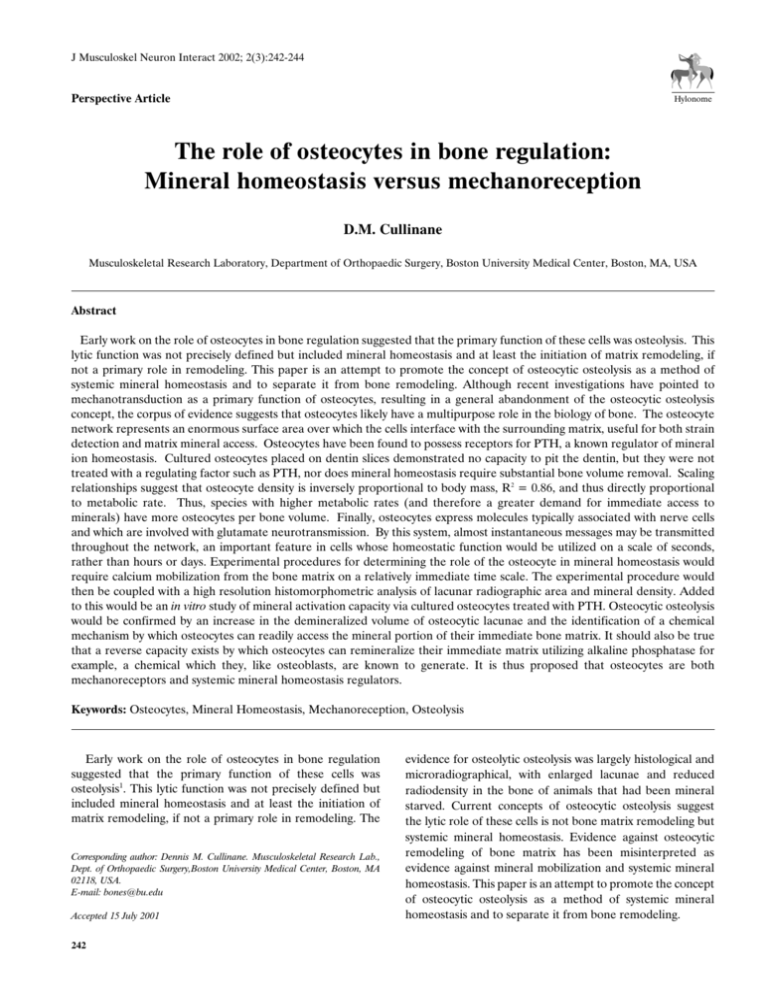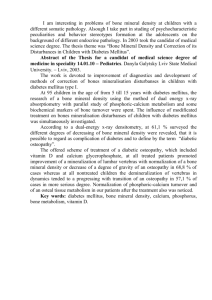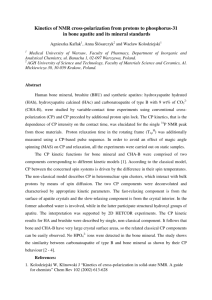The role of osteocytes in bone regulation
advertisement

J Musculoskel Neuron Interact 2002; 2(3):242-244 Perspective Article Hylonome The role of osteocytes in bone regulation: Mineral homeostasis versus mechanoreception D.M. Cullinane Musculoskeletal Research Laboratory, Department of Orthopaedic Surgery, Boston University Medical Center, Boston, MA, USA Abstract Early work on the role of osteocytes in bone regulation suggested that the primary function of these cells was osteolysis. This lytic function was not precisely defined but included mineral homeostasis and at least the initiation of matrix remodeling, if not a primary role in remodeling. This paper is an attempt to promote the concept of osteocytic osteolysis as a method of systemic mineral homeostasis and to separate it from bone remodeling. Although recent investigations have pointed to mechanotransduction as a primary function of osteocytes, resulting in a general abandonment of the osteocytic osteolysis concept, the corpus of evidence suggests that osteocytes likely have a multipurpose role in the biology of bone. The osteocyte network represents an enormous surface area over which the cells interface with the surrounding matrix, useful for both strain detection and matrix mineral access. Osteocytes have been found to possess receptors for PTH, a known regulator of mineral ion homeostasis. Cultured osteocytes placed on dentin slices demonstrated no capacity to pit the dentin, but they were not treated with a regulating factor such as PTH, nor does mineral homeostasis require substantial bone volume removal. Scaling relationships suggest that osteocyte density is inversely proportional to body mass, R2 = 0.86, and thus directly proportional to metabolic rate. Thus, species with higher metabolic rates (and therefore a greater demand for immediate access to minerals) have more osteocytes per bone volume. Finally, osteocytes express molecules typically associated with nerve cells and which are involved with glutamate neurotransmission. By this system, almost instantaneous messages may be transmitted throughout the network, an important feature in cells whose homeostatic function would be utilized on a scale of seconds, rather than hours or days. Experimental procedures for determining the role of the osteocyte in mineral homeostasis would require calcium mobilization from the bone matrix on a relatively immediate time scale. The experimental procedure would then be coupled with a high resolution histomorphometric analysis of lacunar radiographic area and mineral density. Added to this would be an in vitro study of mineral activation capacity via cultured osteocytes treated with PTH. Osteocytic osteolysis would be confirmed by an increase in the demineralized volume of osteocytic lacunae and the identification of a chemical mechanism by which osteocytes can readily access the mineral portion of their immediate bone matrix. It should also be true that a reverse capacity exists by which osteocytes can remineralize their immediate matrix utilizing alkaline phosphatase for example, a chemical which they, like osteoblasts, are known to generate. It is thus proposed that osteocytes are both mechanoreceptors and systemic mineral homeostasis regulators. Keywords: Osteocytes, Mineral Homeostasis, Mechanoreception, Osteolysis Early work on the role of osteocytes in bone regulation suggested that the primary function of these cells was osteolysis1. This lytic function was not precisely defined but included mineral homeostasis and at least the initiation of matrix remodeling, if not a primary role in remodeling. The Corresponding author: Dennis M. Cullinane. Musculoskeletal Research Lab., Dept. of Orthopaedic Surgery,Boston University Medical Center, Boston, MA 02118, USA. E-mail: bones@bu.edu Accepted 15 July 2001 242 evidence for osteolytic osteolysis was largely histological and microradiographical, with enlarged lacunae and reduced radiodensity in the bone of animals that had been mineral starved. Current concepts of osteocytic osteolysis suggest the lytic role of these cells is not bone matrix remodeling but systemic mineral homeostasis. Evidence against osteocytic remodeling of bone matrix has been misinterpreted as evidence against mineral mobilization and systemic mineral homeostasis. This paper is an attempt to promote the concept of osteocytic osteolysis as a method of systemic mineral homeostasis and to separate it from bone remodeling. D.M. Cullinane: Osteocytes and Mineral Homeostasis Recent investigations have pointed to mechanotransduction as a primary function of osteocytes2, resulting in a general abandonment of the osteocytic osteolysis concept. The evidence for mechanotransduction comes principally from quantitative assays for gene upregulation including cAMP, osteocalcin and IGF-1 in response to mechanical load3. Osteocytes maintain an extensive and interconnected network via multiple processes within canaliculi and functional gap junctions4, ideal for a strain detection system or a mineral regulation network. The osteocyte network also represents an enormous surface area over which the cells interface with the surrounding matrix5, useful for both strain detection and matrix mineral access. The corpus of evidence suggests that osteocytes likely have a multipurpose role in the biology of bone. Osteocytes have been found to possess receptors for PTH2, a known regulator of mineral ion homeostasis. Cultured osteocytes placed on dentin slices demonstrated no capacity to pit the dentin6, but the level of resolution of matrix depth in the study was only 2 microns which would not detect osteocytic osteolysis to a depth below a micron. The current osteocytic osteolysis concept does not suggest that osteocytes can, like osteoclasts, remove substantial quantities of whole bone matrix (organic and mineral phases). It suggests that they are capable of accessing bone matrix minerals to some relatively superficial depth, which multiplied by their immense surface area, would mean access to a substantial amount of mineral volume. In conjunction with this concept, osteocytes have in fact been shown to produce acid phosphatase, a known mobilizing agent of bone mineral7. Further, scaling relationships suggest that osteocyte density is inversely proportional to body mass8, R2 = 0.86, and thus directly proportional to metabolic rate9. Thus, species with higher metabolic rates (and therefore a greater demand for immediate access to minerals) have more osteocytes per bone volume (Fig. 1). Additionally, osteocytes express molecules typically associated with nerve cells and which are involved with glutamate neurotransmission2. By this system, almost instantaneous messages may be transmitted throughout the network, an important feature in cells whose homeostatic function would be utilized on a scale of seconds, rather than hours or days. Experimental procedures for determining the role of the osteocyte in mineral homeostasis would require calcium mobilization from the bone matrix on a relatively immediate time scale. This could be effected by an in vivo model of calcium starvation and PTH treatment, for example. The instantaneous mineral demand and shortened experimental period would not allow for the confounding effect of osteoclast differentiation and activation. The experimental procedure would then be coupled with a high resolution histomorphometric analysis of lacunar radiographic area and mineral density, and TRAP staining. Added to this would be an in vitro study of mineral activation capacity. Cultured osteocytes could be treated with PTH and the surrounding media then assayed for mineral mobilizing l Body Mass (Kg) Figure 1. Osteocyte Density vs. Body Mass molecules (TRAP). Osteocytic osteolysis would be confirmed by an increase in the demineralized volume of osteocytic lacunae and the identification of a chemical mechanism by which osteocytes can readily access the mineral portion of their immediate bone matrix. It should also be true that a reverse capacity exists by which osteocytes can remineralize their immediate matrix utilizing alkaline phosphatase for example, a chemical which, like osteoblasts, they are known to generate6. In summary, osteocytes are ideal candidates for systemic mineral homeostasis regulation. They represent an enormous surface area, their density is proportional to a species' metabolic demands, radiographically they have demonstrated mineral matrix dissolution, and there is evidence that they have the biochemical capacity to both access and deposit matrix minerals. It is proposed that osteocytes are both mechanoreceptors and systemic mineral homeostasis regulators. References 1. Belanger LF. Osteocytic osteolysis. Calcif Tissue Res 1969; 4:1-12. 2. Noble BS, Reeve J. Osteocyte function, osteocyte death and bone fracture resistance. Mol Cell Endocrinol 2000; 159:7-13. 3. Mason DJ, Hillman RA, Skerry TM. Constitutive in vivo mRNA expression by osteocytes of beta-actin, osteocalcin, connexin-43, IGF-I, c-fos and c-jun, but not TNF-alpha nor tartrate-resistant acid phosphatase. J Bone Miner Res 1996; 11:350-357. 4. Doty SB, Nunez EA. Activation of osteoclasts and the repopulation of bone surfaces following hibernation in the bat, Myotis lucifugus. Anat Rec 1985; 213:481-495. 5. Parfitt AM. The cellular basis of bone turnover and bone 243 D.M. Cullinane: Osteocytes and Mineral Homeostasis loss: a rebuttal of the osteocytic resorption-bone flow theory. Clin Orthop Rel Res 1977; 127:236-247. 6. van der Plas A, Aarden EM, Feijen JH, de Boer AH, Wiltink A, Alblas MJ, de Leij L, Nijweide PJ. Characteristics and properties of osteocytes in culture. J Bone Miner Res 1994; 9(11):1697-1704. 7. Whitten PE, Villwock W, Peters N, Hall BK. Bone 244 resorption and bone remodelling in juvenile carp, Cyprinus carpio. L. J. Appl. Ichthyol 1999; 16:254-261. 8. Cullinane DM, Deitz L. The role of osteocytes in mineral homeostasis. 12th Conf Europ So Biomechanics 2000 Dublin. 9. Schmidt-Nielsen K. Animal Physiology: Adaptation and Environment. Cambridge University Press; 1980.







